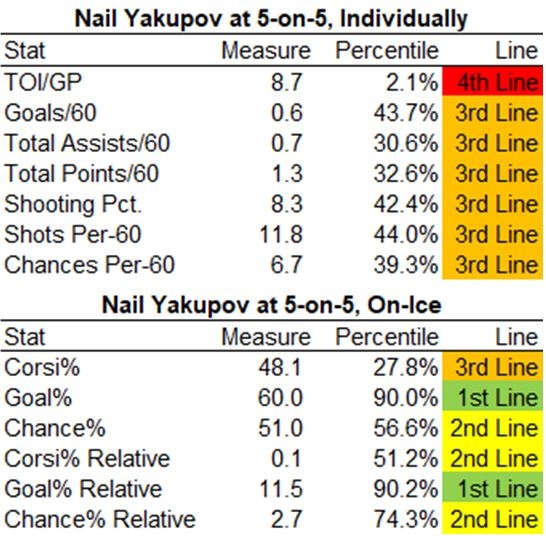Jun 28, 2018
Yakupov can be a useful depth player
The former first-overall pick is probably going to be readily available this summer at the league minimum, Travis Yost writes.
By Travis Yost

One of the most fascinating challenges for NHL front offices is differentiating between perceived value and actual value. That’s front and centre in the case of UFA winger Nail Yakupov.
It’s hard to call Yakupov a bust, but there’s no doubt he has under-delivered compared to other former first-overall picks. The No. 1 selection in any draft can alter the direction of a franchise for a decade – look no further than the likes of Sidney Crosby, Patrick Kane, Steven Stamkos, and Connor McDavid as evidence of that.
Yakupov did alter the direction of the Edmonton Oilers, but not in a good way. He played four years in Edmonton, each one worse than the last, and was eventually dumped via trade to St. Louis. The production was no better in St. Louis, and the one-year deal he inked with Colorado in 2017-18 felt every bit the part of a last hurrah for a player who was – just a few years prior – considered the single-most talented player in his draft class.
Over the span of six seasons, Yakupov’s perceived value has transitioned from ‘franchise-altering superstar’ to ‘player dangerously close to being pushed out of the league’. It’s possible that neither are correct. There’s no doubt we overrated his abilities six years ago – that much, with hindsight, is obvious. But it’s interesting that he is searching for a job, just a few months removed from a contract that Colorado effectively signed for the league minimum. Is it possible that we are now underrating what Yakupov brings to the table?
Yakupov’s counting numbers won’t blow anyone away (16 points in 58 games), but context is critical here. Colorado sheltered Yakupov way down the lineup. His common linemates including Alex Kerfoot, Dominic Toninato, and Tyson Jost. His most common defensive pairmates were Erik Johnson and Nikita Zadorov. He did manage to see a little bit of power-play time, but saw nothing on the penalty kill. In short, he was utilized entirely as a depth forward – one that Colorado could plug in on a third or fourth line for a little bit of offence.
He produced reasonably for a player in his position. Let’s look at Yakupov’s 5-on-5 numbers first, and how they compare to regular NHL forwards around the league last season.

We know head coach Jared Bednar was extremely protective in his deployment of Yakupov and that has to count for something. Coaches aren’t infallible but they generally have decent reads on their personnel. The fact that Yakupov was one of the less commonly utilized forwards must be taken into consideration.
It’s interesting that Yakupov was reasonably productive in the offensive zone in his limited minutes. Individually he generated shots, scoring chances and goals at a third-line rate – better than about 30 to 40 per cent of the forwards around the league.
It’s one of the big reasons why you must look beyond his simple counting numbers. Yakupov saw very little ice time. But in the minutes he did see, he did quite well with them. Doubly so when you consider that he wasn’t exactly playing with linemates or defensive units who create much offence.
Perhaps more interesting though are the on-ice numbers Colorado realized with Yakupov on the ice. Depth lines – and, correspondingly, depth players – tend to get crushed territorially across the league. But that wasn’t the case with Yakupov. The Avs outscored teams with Yakupov out there (note: he did carry quite a high PDO, thanks in large part to fantastic goaltending behind him), and broke even in terms of scoring chances and shots.
Moreover, Colorado was actually better from a territorial perspective when Yakupov was on the ice – you’ll notice his “team relative” numbers are all well into the positive, indicating that Colorado actually yielded more relative offensive zone time when he was taking shifts.
So we know Yakupov, albeit in limited minutes, was useful for Colorado at 5-on-5. But he didn’t just play there. Yakupov also saw minutes on the Avalanche second power-play unit. These secondary groups for Bednar didn’t perform well at aggregate, but it’s interesting how much Yakupov individually created when he was out there. Same measures, this time on the man advantage:

Yakupov picked up a handful of goals on the power play, but again, the sample size was pretty small there. However, when we look at measures that work better in smaller samples (e.g. shot generation or scoring chance generation), you still reasonably conclude the same thing.
Yakupov was, in one word, active. You wonder if he was maybe taking too many shots – only six per cent of forwards generated more attempts around the league on a rate basis. And, his individual scoring chance numbers were a bit lower. Still, I think this is the sort of stuff you want to see from a guy trying to amplify his skill set in limited minutes.
I think the point I’m making here is that Yakupov’s flaws at this point in his career are well understood. He’s not great defensively, he never produced offensively the way many around the league envisioned, and he’s at the point in his developmental curve where it’s hard to expect he’ll take another leap forward.
That said, Yakupov – who played like a third-line attacker last season – is probably going to be readily available and, again, at the league minimum.
For teams needing another weapon further down the lineup, you could do a lot worse.



